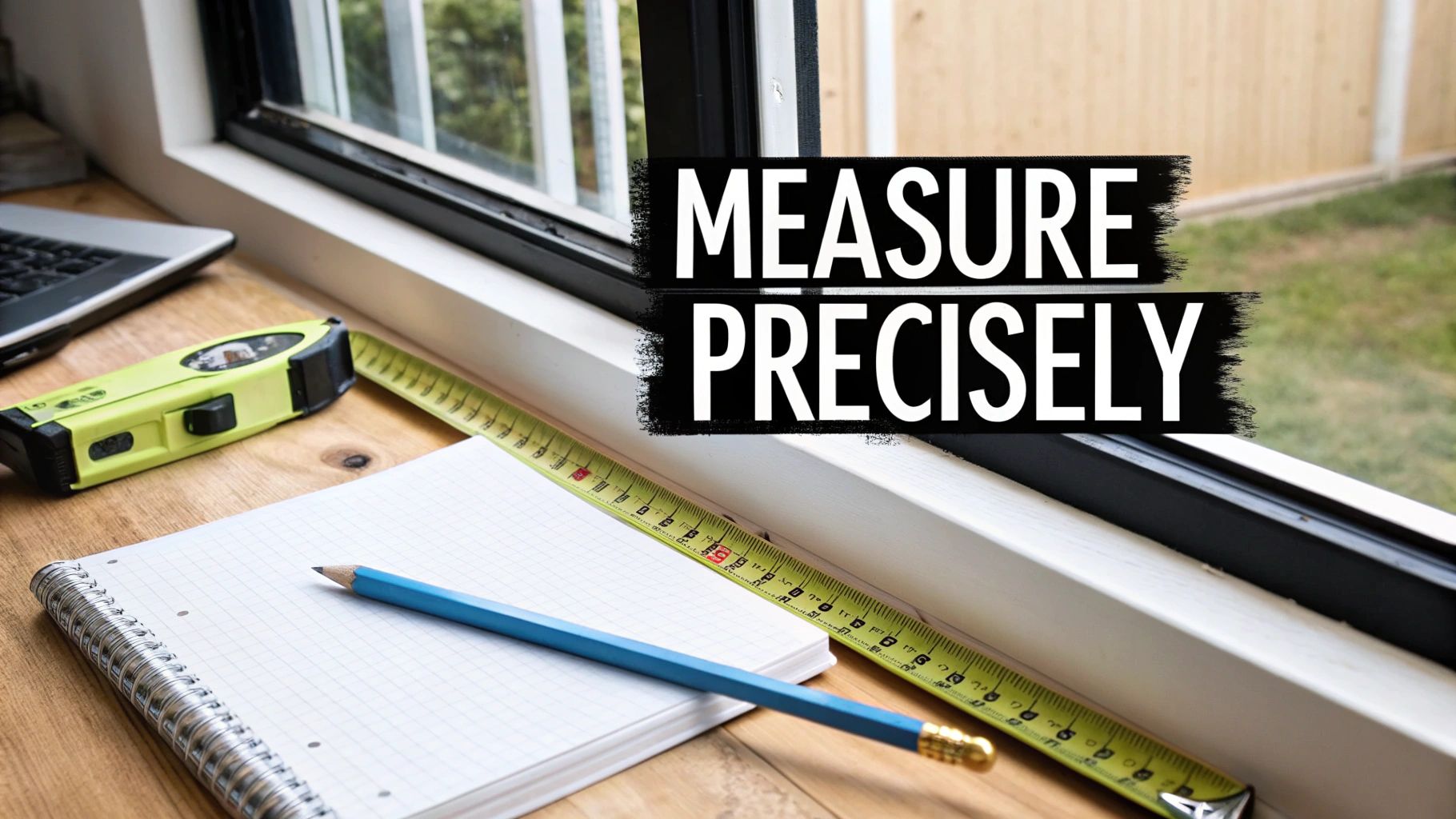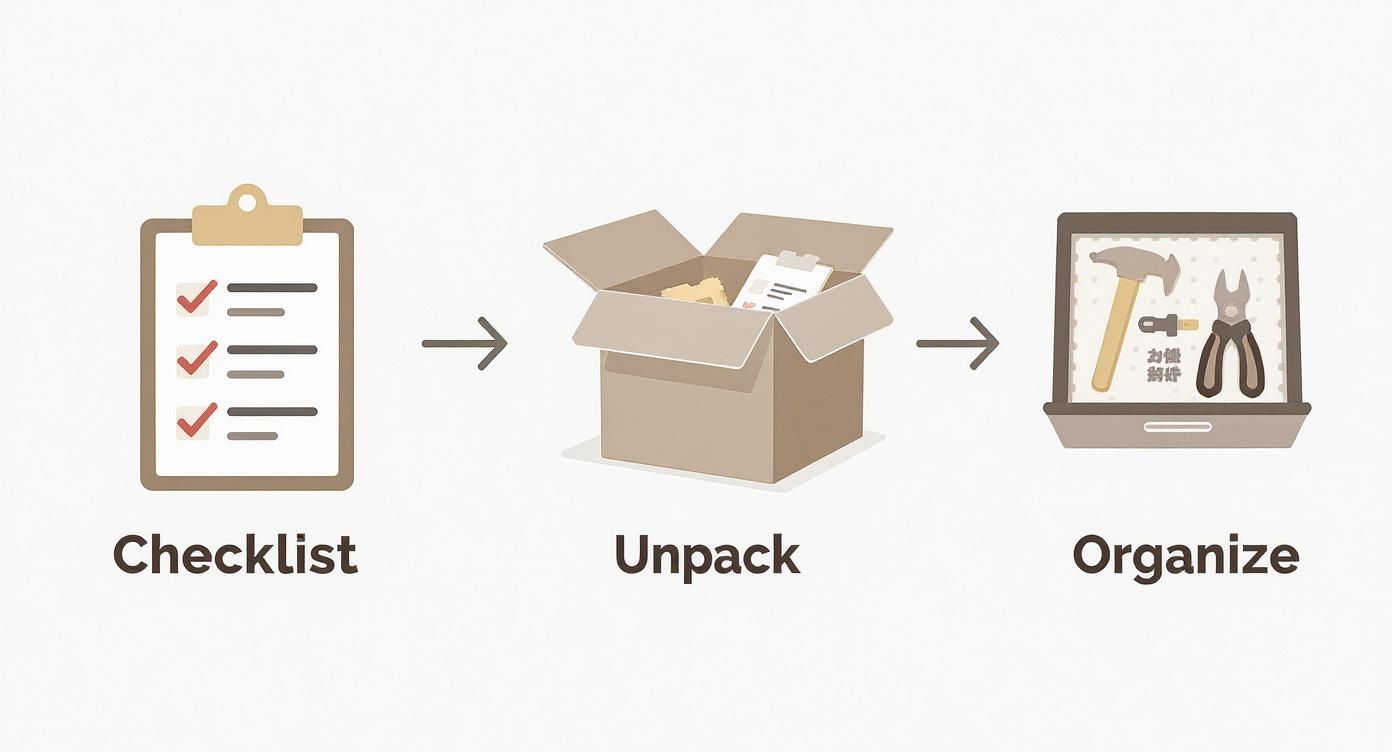
How to Install Roman Shades in Under an Hour: A DIY Guide
Learning how to install Roman shades is one of the most satisfying DIY projects a homeowner can tackle. It’s a simple process that boils down to three key stages: measuring correctly, placing your brackets securely, and hanging the shade. Get these steps right, and you'll have a professional-looking result that elevates your room's style.
This guide provides the experience-backed steps I’ve used for countless installations, ensuring you get it right the first time.
Table of Contents
- Your Pre-Installation Game Plan
- Unboxing and Assembling Your Toolkit
- Mastering Bracket Placement and Installation
- Attaching the Shade and Adding Finishing Touches
- Troubleshooting Common Installation Hiccups
- Keeping Your Roman Shades Looking New
- Frequently Asked Questions
Your Pre--Installation Game Plan
Before you pick up a drill, a little planning goes a long way. The decisions you make now will set the stage for a smooth, frustration-free installation. Think of this as your roadmap to success.
The first and most critical choice is deciding between an inside mount and an outside mount. An inside mount fits snugly within the window frame for a clean, built-in aesthetic. An outside mount is installed on the wall or trim above the window, perfect for maximizing light control or hiding a less-than-perfect window frame. This choice directly impacts how you'll measure.

The Two Mounting Styles Explained
Understanding the pros and cons of each mounting style is essential for getting the look and function you're after.
- Inside Mount: This style offers a minimalist, custom appearance, ideal for showing off attractive window trim. The catch? It requires a minimum window depth for the headrail to fit, and you might notice small light gaps along the sides.
- Outside Mount: This option offers superior flexibility. It can make a window appear larger and provides better light blockage since the shade overlaps the window opening entirely. It’s my go-to solution for shallow window casings or out-of-square frames common in older homes.
The difference in light control between these styles is significant. If you're on the fence, you can explore more about light-filtering vs. blackout options in our detailed guide to match the right mount with the right fabric.
Insider Tip: For outside mounts, I always add at least 2-3 inches to each side of the window measurement. This ensures full coverage and minimizes those pesky slivers of light peeking through the edges.
Inside Mount vs Outside Mount: A Quick Comparison
Feeling stuck? This quick comparison will help you confidently choose the right mounting style for your windows.
| Feature | Inside Mount | Outside Mount |
|---|---|---|
| Look & Feel | Clean, minimalist, built-in appearance | Creates the illusion of a larger window; traditional look |
| Best For | Showing off attractive window trim; deep window sills | Hiding imperfect frames; shallow windows; maximizing darkness |
| Light Control | Good, but may have small light gaps on the sides | Excellent; overlaps frame to block more light |
| Measurement | Requires precise width and depth measurements of the frame | More forgiving; measures the area you want to cover |
| Considerations | Window must have enough depth to accommodate the headrail | Covers trim; requires enough wall space above the window |
Ultimately, the right choice comes down to your specific windows and the look you want. Both can look fantastic when done correctly.
How to Measure for Roman Shades with Precision
Inaccurate measurements are the number one cause of installation headaches. Grab a quality steel tape measure—not a fabric one, which can stretch—and measure every single window, even if they look identical. They're often not!
For an inside mount:
Measure the width at the top, middle, and bottom of the window frame. Record the narrowest of these three numbers. Then, measure the height at the left, middle, and right, and record the longest measurement.
For an outside mount:
First, decide where the headrail will sit above the frame. Measure the total width you want the shade to cover (including the extra overlap on each side). Then, measure the height from the top of where the headrail will be down to where you want the shade to fall.
Unboxing and Assembling Your Toolkit
With your new shades in hand, the fun begins. Taking a few minutes to unbox and organize everything is a pro move that will make the actual installation a breeze.
First, unbox everything carefully. I recommend laying out a soft blanket or sheet on the floor to protect both your new shades and your flooring from scratches. Gently pull out the headrail, fabric, and all hardware.
Your Essential Tool Checklist
Having your tools within arm's reach saves you from trips back to the garage. Your kit will come with basics like brackets and screws, but you’ll need a few essentials.
- Power Drill: A must-have for a fast, secure installation. Ensure you have the right drill bits for the included screws and a smaller bit for pilot holes.
- Steel Tape Measure: For double-checking bracket placements with accuracy.
- Level: A small torpedo level is the secret to avoiding a crooked shade that will bug you forever.
- Pencil: For making clean, precise marks for your brackets.
- Stable Stepladder or Stool: Safety first! Never balance on a wobbly chair.
Inventory and Organize Your Hardware
Before drilling, do a quick inventory check. Spread out the hardware—brackets, screws, cord cleats—and compare it against the parts list in the manufacturer’s instructions. This five-minute check can save you from the massive headache of realizing a piece is missing mid-job.
Pro Tip: I use a small magnetic bowl or an empty egg carton to keep screws and small parts organized. This simple trick stops tiny pieces from rolling away and disappearing.
Setting up your workspace correctly is key. For more tips on hanging hardware, see our guide on how to install curtain rods, which shares universal principles for any window treatment.
With everything organized, you're officially ready to start mounting.
Mastering Bracket Placement and Installation
This is where the magic happens. Nailing your bracket placement is the secret to a professional-looking installation. It's the foundation that ensures your shades hang level and operate smoothly.
Using your measurements from the prep stage, transfer those numbers to the window frame or wall with a sharp pencil.
For an inside mount, brackets typically attach to the top of the window casing. Hold a bracket in place near one end and mark where you'll drill. Repeat on the other side, ensuring both are the same distance from the front edge of the frame.
For an outside mount, position your brackets on the wall or trim above the window. Your marks should align with the total width you measured earlier. Use your level to ensure the marks are even—don’t trust the window frame, as they’re notoriously uneven.
Securing Brackets to Different Surfaces
The surface you're drilling into dictates your next move. If you're working with solid wood trim, drilling small pilot holes is a non-negotiable step. A pilot hole, slightly smaller than your screw's diameter, prevents the wood from splitting and guarantees a tight grip.
Drywall presents a different challenge. The included screws often aren't enough to hold the weight alone. You’ll need to use drywall anchors for a secure installation that won’t pull out over time. If you're new to this, we have a guide on how to hang curtain rods in drywall that covers anchoring techniques you can apply here.
Insider Tip: Always check for obstructions before you drill. Window cranks, locks, or alarm sensors can interfere with the shade's operation. Hold the shade up to your marks to simulate its movement and ensure it has a clear path.
Final Checks Before Installation
With pilot holes drilled or anchors in place, attach the brackets with your power drill. Leave the screws a tiny bit loose for micro-adjustments.

This process of checking, unpacking, and organizing ensures a smooth installation.
Place your level across the tops of the brackets one last time to confirm they are perfectly aligned. If they are, tighten the screws fully. A level installation isn't just about looks; it prevents uneven wear on the cords and lifting mechanism.
With your brackets firmly secured, you're ready for the most satisfying step.
Attaching the Shade and Adding Finishing Touches
With your brackets firmly in place, you're on the home stretch. This is where your prep work pays off, and that collection of parts starts to look like a beautiful window treatment.

Locking the Headrail into Place
Carefully lift the headrail up to the brackets. For an inside mount, you’ll likely tilt the front of the headrail up, slide it into the brackets, and then push the back edge upward until it locks in with a click. For an outside mount, it's often a simpler motion of pushing the headrail straight back onto the brackets.
The exact mechanism can vary between brands, so a quick glance at the manufacturer's guide is always a good idea. Once you hear that solid click, give the headrail a gentle but firm tug to be sure it's fully seated and secure.
Finalizing the Valance and Safety Features
Now for the details that give your installation a polished look. Most Roman shades come with a matching fabric valance to hide the headrail. This piece usually attaches with clips or a hook-and-loop strip. Align the valance with the top of the headrail and press it on firmly.
For any corded shades, installing the safety hardware is a crucial final step, especially with children or pets at home.
- Cord Cleats: Mount the cord cleat to the side of the window frame, high enough to be out of a child’s reach. Wrap the extra cord around it in a figure-eight pattern.
- Tension Devices: If you have a continuous cord loop, the tensioner must be mounted securely to the window frame or wall to keep the cord taut.
These safety features are non-negotiable for creating a safe environment.
With a little guidance, this final stage is surprisingly straightforward. In a global market valued at USD 14.82 billion in 2024, an estimated 70% of Roman shades are installed by homeowners themselves. The average DIY time is just 30 to 45 minutes per window. You can find more insights in this blinds and shades market report.
Testing Your New Roman Shade
Alright, the moment of truth. Slowly raise and lower the shade a few times. Does it glide smoothly without catching? When you raise it, does it fold into neat, even stacks?
If your shade is cordless, test the lift mechanism by gently pushing up or pulling down from the bottom rail. For a motorized version, grab the remote and run it through its full range of motion. This final check ensures everything is working perfectly.
Troubleshooting Common Installation Hiccups
https://www.youtube.com/embed/kgtR3Pz4UcM
Even with careful prep, hiccups can happen. Don't sweat it. Most snags are common and have a simple fix. Let’s walk through the most frequent issues homeowners face.
Your Shade Is Hanging Crooked
This is the number one issue. A crooked shade is a dead giveaway that your brackets aren't perfectly level.
- The Fix: Grab your level and rest it across the tops of the installed brackets. If the bubble isn't centered, one is higher than the other. Slightly loosen the screws on the higher bracket, tap it down until it's level, and then tighten everything back up.
If the brackets are level, double-check that the headrail is fully and evenly snapped into both brackets. It's easy for one side to feel secure when it’s only partially clicked in.
The Shade Won't Raise or Lower Smoothly
A shade that fights you is annoying. This is often just a simple obstruction or a kink in the cord mechanism.
- Check the Cord Path: For corded shades, peek behind the fabric. The lift cords can get twisted or snagged. Gently untangling them is usually all it takes.
- For Cordless Shades: New cordless shades can be stiff. Try raising and lowering the shade fully five to ten times to "break in" the internal spring mechanism. If it still feels stuck, make sure it’s seated correctly in the brackets—an uneven headrail can cause the mechanism to bind.
A level installation is the secret to a smooth operation. When the headrail isn't level, it puts uneven tension on the lifting system, which is a leading cause of operational snags.
Other Quick Fixes for Common Issues
Here are a few more rapid-fire solutions.
- The Valance Won't Attach: Check that the headrail is pushed all the way back into the brackets. If it isn't seated properly, there won't be enough room for the valance to connect.
- Brackets Feel Loose in Drywall: This means your screw missed a stud. Back the screw out and install a more robust drywall anchor rated for the shade's weight. This is a critical safety fix.
- The Shade is Too Wide/Narrow: This traces back to the measuring stage. If an inside-mount shade is a hair too wide, you’ll need a replacement. If it's a bit too narrow, you can often salvage it by switching to an outside mount.
Keeping Your Roman Shades Looking New
Congratulations, your new shades are up! Now, a little routine care is all it takes to keep them looking and functioning perfectly for years.
A light dusting once a week with a feather duster is perfect. You can also use the soft brush attachment on your vacuum to gently go over the fabric. This prevents dust and allergens from working into the fibers.
Long-Term Care and Cleaning
For small spills or smudges, spot-cleaning is your best bet.
Gently blot the area with a clean, damp cloth and a tiny amount of mild soap. Always test it on a hidden spot first to ensure it doesn't affect the fabric color. Keeping shades clean is also a key part of maintaining good indoor air quality.
Don't forget the mechanisms.
- Corded Shades: Check that cords are untangled and wrapped neatly on the cleat.
- Cordless & Motorized Shades: Run them up and down their full range of motion occasionally to keep internal parts moving smoothly.
By the way, pat yourself on the back for choosing the DIY route. Professional installation can cost anywhere from $75 to $150 per window. With the global window covering market expected to reach $54.4 billion by 2034, it's clear more homeowners are choosing user-friendly options they can install themselves. Dive deeper into these trends in this detailed market report.
Frequently Asked Questions
Even straightforward projects can leave you with questions. Let's walk through some common "what-ifs" so you can wrap up your installation feeling like a pro.
Is it hard to install Roman shades yourself?
The short answer is no. Most Roman shades are designed for DIY installation. If you're comfortable using a drill, a tape measure, and a level, you can realistically have a shade installed in under an hour. The two most critical steps are measuring carefully before ordering and ensuring your mounting brackets are perfectly level and secure.
What is the difference between inside and outside mount for Roman shades?
An inside mount fits snugly inside the window casing for a clean, built-in look that's perfect for showing off beautiful window trim. An outside mount is installed on the wall or trim above the window itself. I almost always recommend an outside mount if you're trying to block more light, hide a less-than-attractive window frame, or if your window casing isn't deep enough for an inside mount headrail.
How do you hang Roman shades on an uneven window frame?
This is a very common issue, especially in older homes. The trick is to make the shade level, not the window. If you're doing an inside mount, use your level to get the brackets perfectly aligned with each other, ignoring the slanted frame. For an outside mount, simply mount the headrail level above the window opening. The shade will hang straight and create a clean line that cleverly hides the uneven frame.
How do you clean Roman shades?
Keeping them fresh is simple. For day-to-day dust, a quick pass with a feather duster or the soft brush attachment on your vacuum is all it takes. For a small stain, you can spot-clean the fabric with a cloth dampened with water and a touch of mild soap. Just remember to test it on a hidden area first and blot gently—never rub—to lift the stain.
Ready to find the perfect style for your next project? Explore the beautiful and easy-to-install collection of window treatments at Joey'z Shopping and transform your space today. Find your ideal Roman shades at https://joeyzshopping.com.
